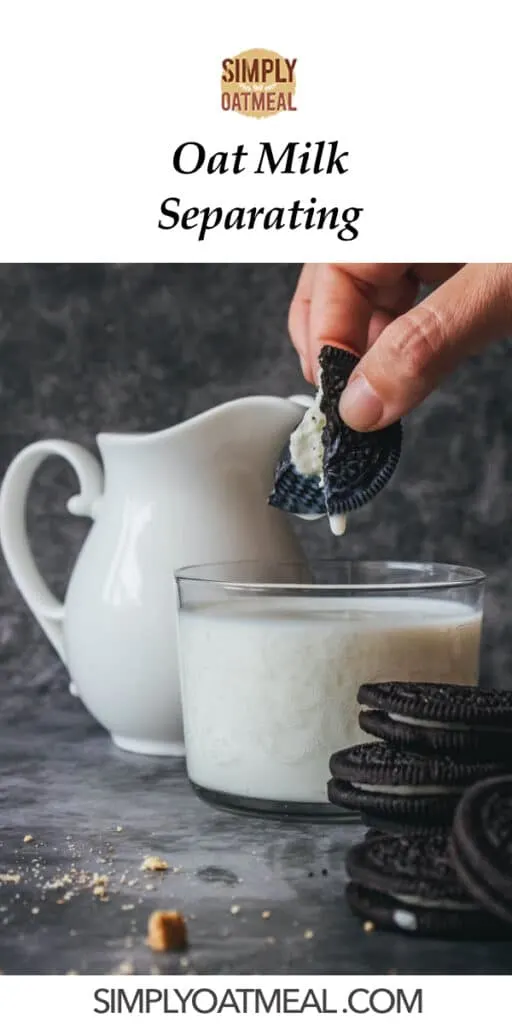More people are switching to nondairy milk options for all the benefits they have to offer. Oat milk is a dairy free beverage that has gained its popularity by being a lactose free, gluten free, nut free and soy free, vegan milk alternative.
Out of all the dairy free milks available such as rice milk, hemp milk, soy milk and almond milk, oat milk risen in popularity quite quickly.
However, oat milk drinkers commonly face the problem of oat milk separating. There are simple solutions to prevent the curdling, emulsification and separation.
So, why is my oat milk separating? It is natural for oat milk to separate when left alone. To emulsify the beverage, seal the container and give it a good shake, the liquid will become an emulsion once again.
This article covers everything that you need to know about oat milk has been explained in details including how to stop the separating. So, to know more, do read on:
What is oat milk?
Oat milk is made by blending oats with filtered water, then straining the beverage to separate the oat pulp from the smooth and creamy liquid.
Yes, the same oatmeal that you are having for breakfast for such a long time.
It consists of whole grain oats that have been pulverized in water. The blended oats are then strained through a fine filter to capture and remove as much pulp and residue as possible.
There is special nut bag used to filter nut milks that can be used instead of cheesecloth, it will make your job easier for sure and it is also reusable.
The leftover oat pulp will contain the fiber and protein present in oat, so we recommend using it as a filler in baked goods, meatloaf or pancake batter. However, oat milk or the liquid obtained is flavorful and contains some of the nutrients from the oats.
Oats absorb more water easily than most nuts and seeds used to make dairy free milks. So, if blended well enough, more of the oats itself will wind up passing through the cheesecloth which gives a creamier texture that most alternative milks are missing.
If you are allergic or intolerant to nuts and/or diary, oat milk will be the best option to go for. If you also want to limit saturated fat intake, then you can switch to oat milk.
It is even advisable for those who are gluten intolerant. Oats really are gluten-free and there are plenty of commercially available brands offering certified GF oats in the market.
A cup of oat milk contains:
- 130 calories
- 2.5g of total fat
- 0g of saturated fats
- 4g of protein
- 16g of carbs
- 2g of fiber
- 35% of RDI (Reference Daily Intake) for calcium.
- 25% RDI for vitamin D
Yes, it is true that it has less protein compared to soy or cow’s milk. However, compared to other type of alternative milk like rice, coconut, almond and cashew, it has more protein. It contains more fiber than cow’s milk (0g), and almond or soy milk (1g).
Besides it also contains a variety of essential minerals and vitamins:
- Manganese
- Zinc
- Copper
- Phosphorus
- Magnesium
- B vitamin thiamin and folate
What is oat milk emulsifier?
The ingredient which most oat milk brands have in common happens to be rapeseed oil. If you research about it, you will find rapeseed oil alongside canola oil are used as an ingredient to make oat milk.
During the early 1970s, through cross-breeding, rapeseed plant was developed which contains advisable levels of erucic acid. The common name of this plant is canola.
It contains more than 2% of its fatty acid profile derived from erucic acid. Based on your location, rapeseed oil and canola oil are interchangeable.
The reason why these oils are used to make oat milk is because they add a rich creaminess that resembles the taste of whole milk. However, once the oil is added to a water based liquid ,an oat milk emulsifier must be added.
Manufactured oat milk brands commonly add dipotassium phosphate as an oat milk emulsifier. The buffering agent acts as an acidity regulator to prevent rapid changes in ph levels that also stabilizes the emulsification.
The dipotassium phosphate is blended into the oat milk to help it remain stable and not separate when the cold liquid is added to hot drinks. The additive is a standard ingredient in manufactured oat milks, however it is not essential when making oat milk from scratch.
How do you emulsify oat milk?
To make oat milk emulsified,you do not need a lot of ingredients. For the best results, use rolled oats when making homemade oat milk.
Add them in a blender with a pinch of salt and 2 tablespoons of oil, you can use canola, but we prefer avocado, coconut or walnut oil. You have to add water in the blender as well.
For a creamy oat milk 3 cups of water will be fine. However, if you want it thinner consistency, then you need to add 4 cups of water in the blender.
When you blend all the ingredients up together, it will emulsify. As a result, you will have non-slimy, smooth and creamy oat milk for your food and beverages.
Afterwards, pour the liquid through a cheesecloth that is placed on top of the bowl or pitcher for straining. Gently squeeze the cheesecloth to get most of the liquid out, and this is how you emulsify oat milk.
Oat milk naturally separates when it is left for some time. To quickly bring the liquid back together, give it a good shake inside an airtight sealed container and the liquid will emulsify back together again.

Tips to emulsify oat milk
Dipotassium phosphate is used to emulsify oil into oat milk. Canola or rapeseed oils have a neutral flavor and are extremely cheap for commercial manufacturing, you can also use them so your oat milk will not taste like anything else.
As previously mentioned, we prefer avocado, coconut or walnut oil because they are much healthier fats. However, there will be a slight hint of flavor that is passed along when the oat milk is emulsified.
Many make the mistake of adding hot oil in the mixture, it is highly advisable that you do not take this step. You need to ensure that you are adding room temperature oil in the blender.
Oil added at room temperature will ensure that the oat milk comes out creamy and smooth. It also ensures that less froth is formed when you blend up the oats with water.
How do you keep oat milk for separating?
If you are using oat milk in your hot coffee or tea and finding that it has separated, then chances are there is a bad reaction. The acidity and heat of the coffee reacts with the cold milk and it ends up separating the fat from the liquid.
If you choose to make oat milk like Oatly, chances are that it will separate if you don’t add the dipotassium phosphate. There is no way to stabilize the liquid and oil together without using an oat milk emulsifier.
Here are some tips to ensure oat milk does not separate when you add it to your hot beverage:
- The right recipe. It may be that you are not making your oat milk properly. You could buy a packaged oat milk and not deal with this problem. For mixing with hot beverages, Oatly Barista Edition is creamy and does not separate. But if you want to make the oat milk at home, then we have used trial and error to discover theperfect recipe to make oat milk without oil. This full flavored blended beverage uses cashews and coconut flakes to add the fattiness that you crave without the need for oil that will inevitably separate from the water base.
- Avoid overheating. After pouring your coffee, wait for a few minutes so that the hot beverage cools down slightly, then add the oat milk. If the drink is too hot when you add ice cold oat milk, there is a large chance the thermodynamic reaction will cause separation.
- Add the oat milk first. Another way to prevent separating is by pouring the oat milk into the cup first. Once you have added the oat milk, then slowly pour the desired amount of hot coffee. This helps as it allows the milk to be tempered and gradually bring it up to the temperature of the coffee preventing the unwanted separation.
- Low-acid coffee. Maybe your coffee is too acidic, which is why the oat milk is reacting with it and ends up separating. Try switching to a low-acid coffee.
There you have it, this is everything that you needed to know about why oat milk is separating and oat milk emulsifiers. Now you not only know how to emulsify oat milk, but also how to keep oat milk from separating.
If your oat milk separates, give it a good shake and the liquid will come back together again. All that is left to do is follow the oat milk recipes and soon enough you can enjoy all the oat milk benefits that it has to offer.
